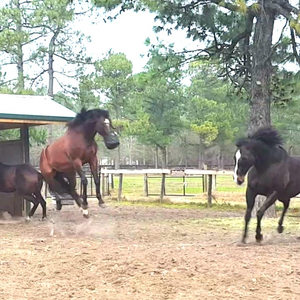Training Horse CPG's for Healthy Locomotion
- Details
- Created: Sunday, 03 February 2019 17:15
- Last Updated: Sunday, 25 July 2021 13:47

Central pattern generators (CPG's) are neural circuits that automatically produce repetitive motion like heartbeat, breathing, and locomotion. For soundness in horses, we are concerned with locomotor CPG’s; the one’s that govern patterns of motion like the walk, trot, and canter gaits. The unfortunate saying “running around like a chicken with no head,” reflects reality. In experiments, decerebrate (without cerebrum) animals and humans have demonstrated normal basic locomotion. Automatic repetitive functions still work even with a large portion of the brain removed or damaged.
In training or rehabilitating horses it is important to understand a little about CPG's because unbalanced gaits will create CPG’s that are unhealthy. For example, with pain, discomfort, injury or even just muscular imbalance, the compensatory movement creates CPG’s. Working on a standing horse, whether it be body work or injecting joints, can provide relief, but it does not necessarily lead to the creation of healthy CPG’s. Pasture rest is also unlikely to be useful as they will continue to practice unhealthy motion. Repetitive movement is required to create CPG's. The horse needs to learn to balanced gaits, side to side and fore-aft. Side to side balance is influenced by spinal rotation (see Horse's Spinal Rotation). Fore-aft balance is influenced by trunk posture.
How can training influence the horse's CPG's?
In working to create new CPG's we are not working with the horse's brain, we are working with the horse's body. Of course, the brain is there and we will deal with the horse's emotions, will, decisions and external stimuli, as usual, but our attention needs to be on how the body, and more specifically the back, is functioning. It is easy to be distracted from this. Repetition will create new CPG's, and each step or stride is one repetition. The objective is that the horse learns the subtle nuances of muscle activity needed to create balance and efficiency, eventually in most steps or strides. Typically, using very slow walk can be the gateway to creating lift for fore-aft balance. Dressage gymnastics, at a very basic level of execution, can help to create healthy spinal rotation. Sometimes there is a need for suppling work preceding the slow walk if the horse is not arriving at the solution to lift the trunk in order to maintain balance in a slow walk.
references:
Marder, E., & Bucher, D. (2001). Central pattern generators and the control of rhythmic movements. Current Biology, 11(23), R986-R996. https://doi.org/10.1016/S0960-9822(01)00581-4
Takakusaki, Kaoru. (2017). Functiona Neuroanatomy for Posture and Gait Control. Journal of Movement Disorders, 10(1), 1-17. https://doi.org/10.14802/jmd.16062

